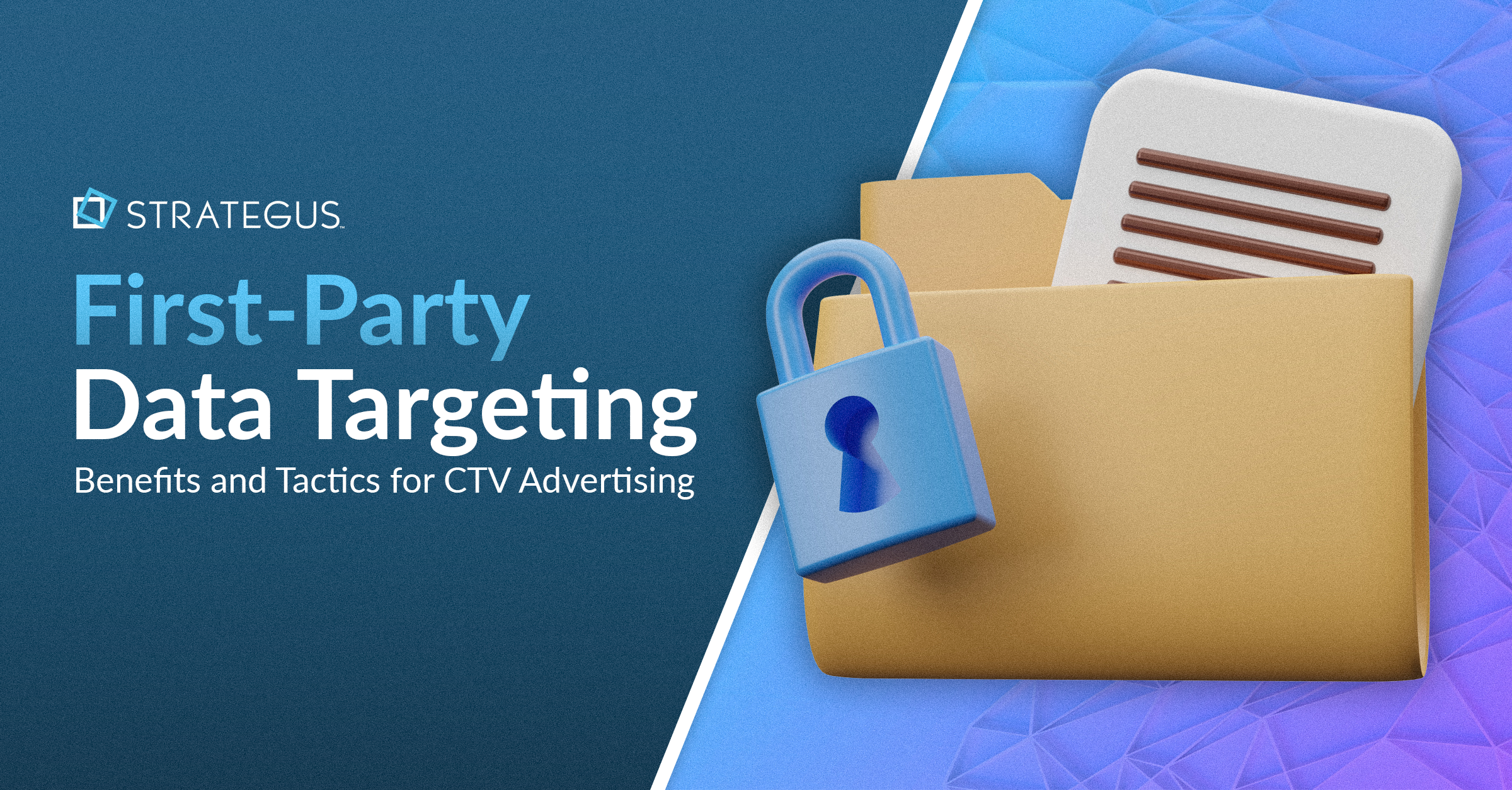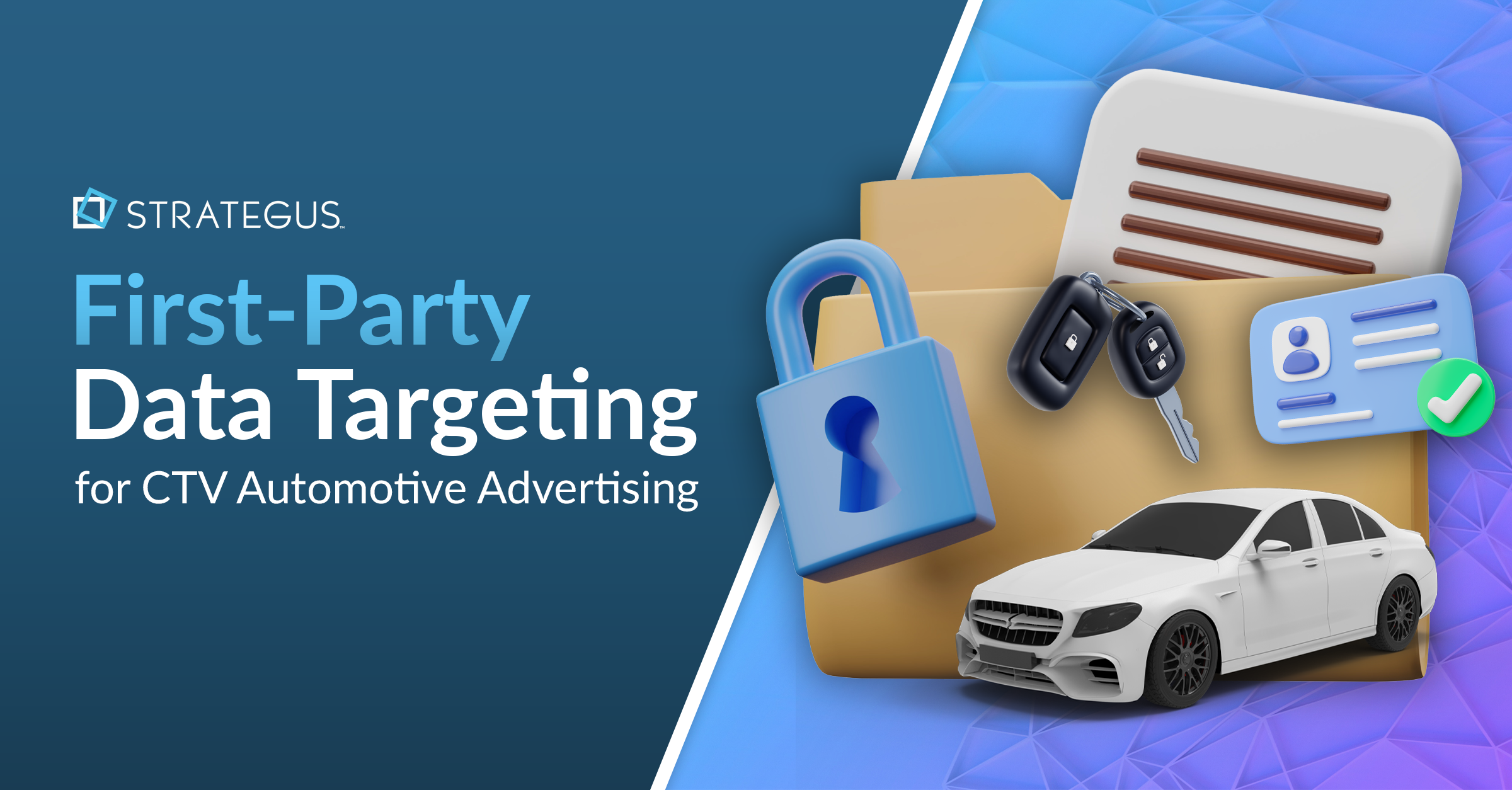- Home
- Strategus Blog
- First-Party Data Targeting: Benefits and Tips for CTV Advertising
First-Party Data Targeting: Benefits and Tips for CTV Advertising
 Traci Ruether
Traci Ruether
11 minutes read

First-party data is information you collect directly from customers on your website, app, or POS system. It’s more accurate and privacy-safe than third-party data, making it great for targeting the right audience.
In CTV advertising, this could be a car dealer showing SUV ads to past buyers or a furniture store promoting coffee tables to people who recently bought sofas.
Key Takeaways
- First-party data is directly collected from customers across owned channels; it's more accurate and privacy-safe than third-party data for CTV audience targeting.
- Sources include CRM lists, purchases, service interactions, website behavior, email engagement, demographics, declared preferences, loyalty activity, and POS, app, or social interactions.
- Strategus activates first-party data via website retargeting, customer whitelisting or blacklisting, custom segmentation, lapsed-customer reengagement, and look-alike modeling to scale reach.
- Advertisers are shifting to privacy-first strategies: IAB reports 71% increasing first-party datasets to stay compliant, improve transparency, and futureproof marketing in a cookieless world.
- Turn your first-party data into precise, privacy-safe CTV campaigns with full-funnel activation and attribution, and speak to a Strategus expert to design your next play.
What is First-Party Data?

First-party data comes from direct interactions with your customers, like in-store visits, website activity, social media, online shopping, surveys, or sign-ups.
A common example is your CRM list, which holds useful details about your customers and leads.
This data can include:
- Names, emails, phone numbers, and addresses
- Purchase history
- Customer service records
- Website actions (like pages visited)
- Email opens and clicks
- Age, gender, job title
- Stated interests and preferences
- Loyalty program activity and points
Examples of First-Party Data Targeting for CTV
At Strategus, we specialize in CTV-first advertising campaigns. This means that we work with agencies and brands to develop programmatic ad campaigns that initially engage potential buyers on the living room TV. Once those viewers have been exposed to a big-screen ad, we then retarget them across supplementary channels to drive conversions.
Using first-party activation, we work with agencies and brands to implement a range of first-party data targeting techniques.
1. Website Retargeting
We retarget users who have visited your website with CTV ads in their home, reminding them of your products or services and encouraging them to return to your site or visit a brick-and-mortar location. This usually involves placing a pixel on your website to gather information about visitors.
Example: Ever received an email about your abandoned shopping cart? This is the same idea, but with a big-screen impact.
2. Current Customer Whitelisting
Deliver personalized ads to known customers, enhancing engagement and loyalty by tailoring messages to their specific needs and preferences.
Example: A local lawn care service could use whitelisting to inform their loyal customers about seasonal specials at the start of the summer.
3. Existing Customer Blacklisting
Avoid wasting ad spend by excluding current customers from acquisition campaigns, ensuring that your ads are only shown to potential new customers.
Example: A bank running a campaign to attract new checking account customers could blacklist their existing customers to avoid showing them irrelevant ads.
4. Custom Segmentation
Segment audiences based on CRM data, purchase history, and website interactions for tailored messaging. This allows you to create highly specific audience segments and deliver the most relevant ads possible.
Example: A travel agency could segment their audience based on past travel preferences, such as adventure travel, family vacations, or luxury getaways, and then tailor their CTV ads to showcase relevant destinations and packages.
5. Lapsed Customer Targeting
Re-engage users who have interacted with your brand but haven’t converted recently.
Example: A cosmetic brand could use lapsed customer targeting to re-engage customers who haven't purchased their product in the past three months. Knowing that most people go through their products every six months on average, the brand could run a CTV ad reminding those customers to restock and offering a discount on their next purchase.
6. Look-Alike Modeling
Use data from your existing customers, website visitors, and CRM files to create look-alike audiences that mirror your best customers, enabling you to reach new, high-potential users who share similar characteristics and behaviors.
Example: A luxury furniture store might use look-alike modeling to identify individuals who exhibit similar shopping patterns as their high-value customers.
This could involve analyzing data on demographics, online browsing behavior, and purchase history to identify individuals who are likely to be interested in their products but have not yet made a purchase.
Why Advertisers Are Investing in First-Party Data
According to the Interactive Advertising Bureau, 71% of brands, agencies, and publishers are increasing their first-party datasets to stay compliant with privacy laws and build more sustainable marketing strategies.
In other words, this type of targeting gives you the chance to reach the right people, at the right time, with the right message and future-proofs your marketing strategy in front of consumers that are getting ever-so antsy with their privacy.

(Source: IAB)
This dependence on first-party data is being spurred by an industry-wide prioritization of transparency and informed consent. In layman's terms, brands and agencies are facing more scrutiny into how customer data is collected and used. As such, advertisers are investing in more consumer-friendly techniques like first-party data activation.
Closing Thoughts: Get the Best of Both Worlds With Strategus
While first-party data is highly valuable, that doesn’t mean it’s the be-all and end-all. At Strategus, we’re big believers in the power of second- and third-party data, as well, which is why we blend multiple sources when designing campaigns.
|
Data Type |
First-Party Data |
Second-Party Data |
Third-Party Data |
|
Summary |
|
Data that’s shared between two businesses through a partnership, acquisition, co-branding, etc. |
Data aggregated and sold by external companies or data providers without a direct link to your business. |
|
Example |
A CRM list containing the contact information, interests, and demographics of customers. |
|
Insight into potential customers’ dietary habits, shopping preferences, and income gathered by third-party providers. |
|
Benefit |
Reliable, accurate, and unique info about a brand’s audience that’s compliant with data privacy regulations. |
|
Comprehensive information that acts as an additional data point for understanding the market as a whole. |
|
Limitation |
|
Dependence on the trustworthiness of a partner; potential privacy and compliance issues. |
Can be less accurate than first- and second-party data and is experiencing signal loss due to how it’s collected. |
We start by getting to know your brand, your goals, and your target audience. From there, we combine every relevant data point at our disposal, including your CRM, internal knowledge, retail media, our ecosystem of 200+ data partners, insight from the publishers and DSPs we integrate with, and more.
We work with you to identify the perfect mix of data to build custom audiences. This could mean using Amazon shopper data to find viewers who’ve been shopping for similar products or Edmunds automotive data to find in-market car buyers.
But we don’t stop there. We’ll also partner with you to launch and optimize these CTV campaigns as an extension of your team. In other words, we combine data-driven tech with human-centered strategy and execution.
Looking to turn raw data into meaningful decisions? Speak to a Strategus expert to learn more about how we can help target the right users at the right time.

Frequently Asked Questions
1. How Can You Get More First-Party Data From Your Audience?
Building your first-party data starts with offering genuine value in exchange for information. Gated content, loyalty programs, newsletter signups, and surveys all create natural opportunities to collect user information. Your website and app can track behavior through pixels, providing valuable insights into customer preferences. The key is making data sharing effortless by keeping forms short and providing clear privacy policies that build trust with your audience.
2. How Is First-Party Data Collected and Stored Securely?
Your owned channels like websites, apps, and CRM systems serve as the primary collection points for first-party data. This valuable information finds its home in secure cloud platforms or encrypted internal databases. Protection comes from implementing access controls, conducting regular audits, and maintaining data encryption that meets compliance standards like GDPR and CCPA, ensuring customer information remains safe from breaches or misuse.
3. How Do You Expand Your First-Party Audience Without Third-Party Cookies?
Growing your audience in a cookieless world requires creative strategies that work. Look-alike modeling helps you find new users who resemble your best customers, while partnerships with publishers provide access to second-party data. Contextual ads on cookieless platforms like CTV offer another path forward. Email marketing and social media engagement remain powerful tools for building your owned audience directly and sustainably over time.
4. How to Monetize First-Party Data With One-To-One Email Marketing?
Your email list becomes a revenue driver when you segment it based on behavior, purchase history, or preferences. Personalized campaigns that match user interests consistently outperform generic messaging. Exclusive offers, content, or product recommendations tailored to each segment drive conversions effectively. Monitoring open and click rates helps refine your messaging, ultimately increasing revenue from repeat and loyal customers who feel understood.
5. How to Use First-Party Data for OTT Ad Personalization?
Connecting user profiles with OTT viewing habits and behaviors creates powerful advertising opportunities. Your CRM data enables tailored video creative, timing, and messaging that resonates with viewers. Recent purchases, interests, or browsing activity inform which ads to serve, improving engagement significantly. This targeted approach increases the likelihood of conversions from OTT viewers who see content that actually matters to them.
6. What Are the Top-Rated First-Party Data Targeting Solutions for Online Retailers?
Leading platforms like Salesforce Marketing Cloud, Klaviyo, Adobe Experience Platform, and Shopify Audiences excel at helping retailers leverage their customer data. These tools streamline the collection, segmentation, and activation of customer information across multiple channels. They enable personalized CTV, email, and social ad campaigns that drive conversions while maximizing the value of existing customer lists through intelligent automation and insights.
7. How Does First-Party Segmentation Improve CTR in CTV Campaigns?
Real customer data transforms generic advertising into personalized experiences that viewers actually appreciate. Your segmented audiences see offers tailored to their specific needs or past behavior rather than irrelevant generic ads. This relevance naturally increases engagement and improves user experience, leading to higher click rates because the ads truly resonate with viewers who recognize the value being offered.
8. How to Use 1st-Party Data in Streaming TV Advertising?
Your CRM or site visitor data becomes actionable when uploaded to a CTV platform or DSP. Custom audiences built from this data can be matched to streaming viewers with precision. Purchase history or interests guide which personalized ads to serve, creating relevant experiences. Retargeting and look-alike models help scale your campaigns effectively while maintaining the precision that makes first-party data so valuable.
9. Who Enables First-Party Data Activation in Real Time?
Leading platforms like The Trade Desk, LiveRamp, and Adobe Real-Time CDP excel at instant first-party data activation. These sophisticated tools create seamless connections between your customer data and programmatic platforms. Timely and relevant ads can then be served across streaming, display, and social media channels without delays or manual updates, ensuring your messaging reaches audiences when it matters most.
10. What Are the Advantages of Using First-Party Travel Data for Targeting?
Travel data from your customers reveals invaluable insights, including booking habits, preferred destinations, and travel frequency patterns. These insights enable you to promote relevant deals, upsells, or travel packages that match individual preferences. Ad accuracy improves dramatically, bookings increase, and customer loyalty strengthens when offers align perfectly with each traveler's specific preferences and history, creating experiences that feel personalized rather than promotional.

Traci Ruether is a content marketing consultant specializing in video tech. With over a decade of experience leading content strategy, she takes a metrics-driven approach to storytelling that drives traffic to her clients' websites. Follow her on LinkedIn at linkedin.com/in/traci-ruether or learn more at traciruether.com.
Strategus is a managed services connected TV(CTV) advertising agency with over 60,000+ campaigns delivered. Find out how our experts can extend your team and drive the result that matter most.
Talk to an Expert
Table of Contents
Seeking a Custom CTV Strategy That Delivers?
What to read next

How Auto Dealers Can Build a Winning First-Party Data Strategy
Your Dealership’s Data is More Powerful Than You Think
4 minutes read
App Event Tracking: Tie Mobile App Activity to CTV Campaigns
Let’s say you’re running a CTV campaign for a personal finance app.
5 minutes read

Stop Guessing Who Your Audience Is — Let Their Apps Tell You
Connected TV (CTV) targeting often falls in one of two camps.
8 minutes read
See Who Bought After Your Ad + How Much They Spent
You can’t improve what you can’t measure. And for years, that’s been a major problem with TV advertising.
4 minutes read
















